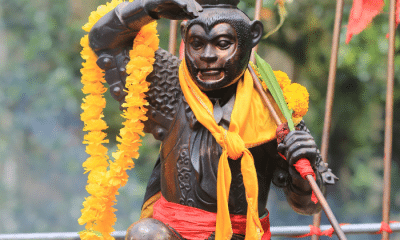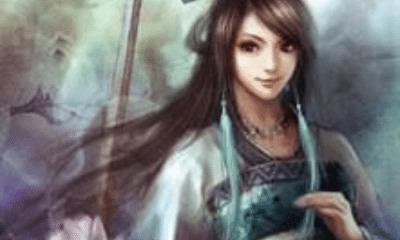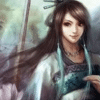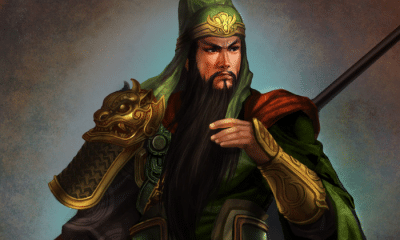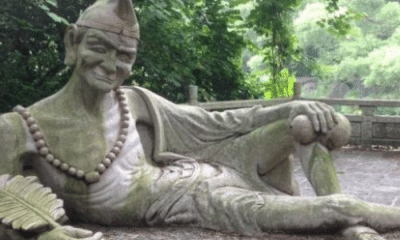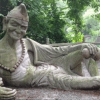Chinese
Leigong: The Chinese Thunder God
The Chinese god of thunder was not a force of chaos, but an honorable servant of the Jade Emperor. Read on to find out how Leigong punished evil, and why his punishments were sometimes brought down on the wrong people.
In Chinese folklore and religion, the god of thunder looked like a terrifying creature. With blue skin, bat wings, and wicked weapons, Leigong seemed horrible.
However, he was known to be a good-natured god who smiled often and drove away the forces of evil. Ancient legends and modern charms remember him as an obedient and helpful deity.
Leigong was not, however, without fault. Darkness and misunderstanding could make the good suffer as well as the wicked.
Leigong had immense power, but it was believed that this could be harnessed. Magical texts and commands from authority could make the god of thunder drive away malevolent spirits and even punish those guilty of crimes on Earth.
Leigong the Punisher
Leigong is the thunder god of both Taoism and the folklore-based mythology of China. His cult seems to have its origins early in China.
Leigong belongs to an obvious and wide-spread archetype in Asia. Like many thunder gods of that continent, he is shown as a monstrous deity who creates thunder by beating on massive drums.
In China, he is often shown with bat wings, large claws, and a bird-like beak. He usually has blue skin.
Despite this monstrous appearance, however, Leigong was often shown as a friendly deity. He smiled often and acted in the cause of righteousness rather than malice.
According to legend, Leigong had been born as a mortal. Eating a peach from a tree that originated in Heaven, however, gave him his divine form.
The Jade Emperor gave Leigong his drum. He was given a mace and a hammer to beat it with.
Leigong also received a chariot. This was driven by a young boy called A Xiang.
After giving Leigong these gifts, the Jade Emperor commanded him to go out to punish the wicked. Leigong was eager to strike down those who committed evil, but he sometimes grew confused as to who he should direct his wrath toward.
One of his greatest problems was that the sky grew dark whenever he descended to Earth. Without light, Leigong could not accurately aim his strikes and sometimes killed innocent people as well as the guilty.
Leigong was also known to overstep the definition of evil. While his intentions were honorable, he sometimes killed those who did not deserve such a harsh punishment.
One of these victims was a young woman named Dianmu.
One day, Dianmu threw away a husk of rice that was too hard for her elderly mother to chew. Believing she was committing a sin by wasting food, however, Leigong struck her down.
The Jade Emperor took pity on Dianmu and resurrected her as a goddess. Because he had killed her, Leigong was made to take responsibility for Dianmu.
She became his wife and assisted him in his duties. Dianmu was the goddess of lightning who used mirrors to light the world so her husband would hit the right targets.
The story of Dianmu and Leigong’s marriage explained why lightning flashed shortly before thunder. Dianmu’s light was not always enough for Leigong to see by, however, so sometimes innocent people were still killed by lightning strikes.
My Modern Interpretation
Leigong had few official temples in China, but that did not mean that he was not prayed to often. While Taoist temples were rarely dedicated to him, folk belief provided the god with ample reverence.
Leigong was a punisher, but he was not an evil god. While he occasionally struck the innocent, he could also be a force for good.
The people who prayed to Leigong did not do so to avoid his wrath because they believed that good people were only struck accidentally. Instead, they prayed that the god would focus his powers on those that they thought of as wicked.
Physical artifacts of these prayers are among the most famous charms of China.
Popularly known as Lei Ting curse charms, these talismans can be found throughout China and Vietnam. They are popular among collectors for both their imagery and supposed magical properties.
Lei Ting, which comes from an abbreviated form of Leigong’s name and the word for “thunder,” often take the form of cash coins. They are typically inscribed with incantations written in Fuwan, a religious text, rather than the more widely-known Hanzi characters.
These incantations frequently call on Leigong to punish the wicked or, more broadly, to drive away evil spirits. They are often written as though they were orders from the Jade Emperor himself.
The Lei Ting curse charms come from ancient practices that are deeply embedded in folk religion rather than the organized rituals of Taoism.
In ancient China, it was believed that malevolent spirits could be dealt with in the same way as human enemies. Exorcists were often hired to throw spears or shoot arrows to drive away these invisible foes.
With the invention of a writing system, there was a new way to fight these spirits. The Hanzi characters were believed to have magical properties that, when used in the right way, could drive off sources of evil.
Rather than using weapons or displaying bodies to strike fear into spirits of evil, practitioners of magic could then use text to magically dispel negative forces.
The superstition that held writing to be magical was only furthered by the spread of imperial authority. As the Han Empire expanded its decrees took on additional authority, and the very text used to write them came to be seen as powerful.
To the people of Imperial China, therefore, no command could be as powerful as a written order from a figure of great authority. The Han Emperor had such authority on Earth, but for spirits the greatest authority was the Jade Emperor.
Exorcists wrote incantations in the Jade Emperor’s voice to frighten away spirits and dispel negative energy. These began to increasingly resemble government edicts and, eventually, coins.
Because the tradition already existed that Leigong enforced the punishment of evildoers, he became a popular figure to appeal to in these texts. They were written in the same style that it was imagined the Jade Emperor would command him to strike down the wicked.
The commands to Leigong on these charms emphasized the speed with which they were to be carried out. Sometimes they called for general protection from spirits or forces of evil, while at others they called for specific demons or people to be singled out.
Such amulets were commonly purchased from Taoist masters, who began to use the Fu characters to make them more magical. This meant that the texts could often only be read by the writer, but the purchaser believed that Leigong could still understand the meaning.
Today Lei Ting curse charms are still made, although they are more often mass-produced based on older examples. While some occasionally serve their original purpose, many more are sold as collector items, souvenirs, or decor.
In Summary
In both folk beliefs and the organized Taoist religion, Leigong was the god of thunder. Born a human, he was made a god after eating fruit from Heaven.
He had a frightful appearance with blue skin, sharp claws, bat-like wings, and a beak. He often smiled, however, and was seen as a generally good-natured deity.
Leigong was commanded by the Jade Emperor to strike down evil spirits and wicked people. He did not always execute this task perfectly, however.
Because he could not see in the dark, he sometimes hit the wrong person by mistake. Others, like his eventual wife, were struck down because Leigong misinterpreted their benign actions as evil.
His wife, however, began to use mirrors to make light flash before he struck. The lightning she made allowed him to see his targets more clearly, although mistakes still happened and good people were occasionally struck.
Chinese folklore held that Leigong would obey commands from an authority, in his case the Jade Emperor. This belief was integral in the creation of the Lei Ting curse charms.
Using the model of imperial decrees, these charms called on Leigong to drive away evil spirits and, sometimes, wicked people. Evolving from ancient folk customs, they remain popular today as both protective charms and collectible art.


